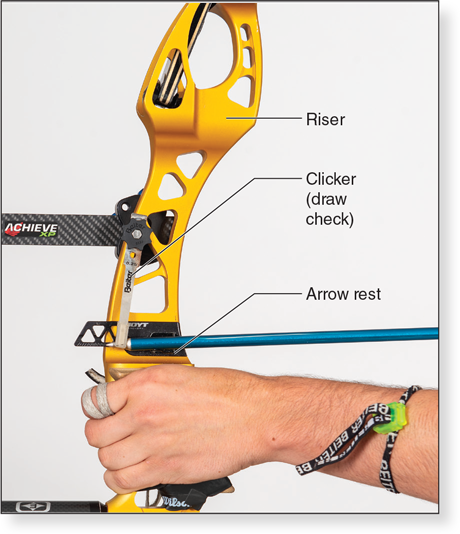Understanding the use of clickers in archery
This is an excerpt from Archery-5th Edition by Kathleen Haywood,Catherine Lewis.
Most archers using a finger release, whether they have a recurve or a compound bow, eventually add a device called a clicker to their bow (figure 8.5). Typically, a clicker is a piece of spring steel about 1/4 inch (0.6 cm) wide and 3 inches (7.6 cm) long. It is mounted in the sight window of the handle riser. The upper end is anchored, and the lower end is free and extends to a point in front of the arrow rest. When you nock the arrow, the arrow is placed under the clicker—that is, between the clicker and the handle riser. The position of the clicker is adjusted so that when you reach full draw, the clicker just begins to slide down the arrow tip. When you are satisfied that the shot is set up, aim and increase back tension. As back tension increases, the draw hand moves the bowstring and the arrow back so that eventually the arrow slides out from under the clicker. The clicker slaps the handle riser and makes a noise, hence its name. You release only on the sound of the clicker. Archers who would like to use a clicker but have longer arrows can extend a plate out from the bow and angle the clicker to strike this plate instead of the bow itself.

The clicker facilitates the use of back tension, plus it discourages anticipation of the release because the archer is never quite sure when back tension will have increased enough to slide the arrow from under the clicker. For finger shooters, these are important advantages in setting up consistent and well-executed shots. Most Olympic-style shooters use clickers. Finger shooters in bowhunter classifications might not be allowed to use clickers.
Another advantage to using a clicker is an identical draw length on every shot. Draw length doesn’t vary, so the thrust imparted to the arrow doesn’t vary even slightly on any shot. In fact, it is not clear whether the clicker was invented as a draw check or as a cure for snap shooting. For long shooting distances, standardizing draw length from shot to shot is important for accurate shooting. Clicker shooters find it advantageous to make sure the draw elbow is high, slightly above nose level, to facilitate using the back muscles in drawing through the clicker.
More Excerpts From Archery-5th EditionSHOP

Get the latest insights with regular newsletters, plus periodic product information and special insider offers.
JOIN NOW
Latest Posts
- Authenticity was key to McKinney’s NIL success
- AI—A new tool for sport PR pros
- Essential skills for sport PR practitioners
- Employ these tactics when pitching a story to the media
- How does ergonomic analysis and intervention enhance safety and reduce injury risk?
- Common movement patterns in competitive cycling


